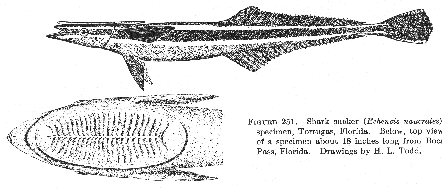Shark sucker Echeneis naucrates Linnaeus 1758
PILOT SUCKER; WHITE-TAILED SUCKER
[Jordan and Evermann, 1896-1900, pp. 2269-2270, as Echeneis naucrates Linnaeus 1758 and E. naucrateoides, Zuiew, 1789.]

Figure 251.—Shark sucker (Echeneis naucrates), 11-inch specimen, Tortugas, Florida. Below, top view of head of a specimen about 18 inches long from Boca Grande Pass, Florida. Drawing by H. L. Todd.
Description—
The most distinctive characters of the shark sucker are mentioned above. It is a very slim fish, 11 or 12 times as long as it is deep, nearly round in cross section, and tapering to a very slender caudal peduncle. The sucking plate, reaching from close behind the tip of the snout back over the nape of the neck even with the middle of the pectoral fin, is about as broad as the head, flat, oval, and with 20 or more very conspicuous transverse plates. The soft dorsal fin (32 to 41 rays) and the anal fin (31 to 38 rays) both originate about the mid length of the body, and they both extend nearly to the base of the caudal fin. Both of them taper, too, from front to rear, but the anal is more concave in form than the dorsal. The caudal fin is slightly concave in old fish but in young ones its central rays are the longest. The ventral fins are pointed like the pectorals below which they stand, and their inner rays are attached to the skin of the abdomen for only a short distance. The broad-based pectoral fins are set so high up on the sides that their upper margins are close below the overlapping edge of the sucking plate.
Color—
The general ground tint is slaty or dark brownish gray, with the belly nearly as dark as the back. Each side is marked by a broad darker brown or sooty stripe with white edges, that runs from the angle of the jaw to the base of the caudal fin but is interrupted by the eye and by the pectoral fin. The caudal fin is velvety black with white corners, a character noticeable enough to give rise to a vernacular name. The dorsal and anal fins are dark slate color or black, more or less margined with white. The pectorals and ventrals are black, either plain or more or less pale edged.
Size—
Reaches about 38 inches.
General range—
Cosmopolitan in warm seas, north as a stray to Halifax, Nova Scotia,[19] on the Atlantic Coast of North America.
Occurrence in the Gulf of Maine—
So far as we can learn no shark sucker of this species has been reported from the Gulf for many years; in fact, the only positive records of it there are for one taken from the bottom of a fishing boat in Boston Bay some time prior to 1839;[20] for a second reported by Wheatland[21] from Salem Harbor (reidentified by [page 486] Goode and Bean as naucrateoides); and for a third reported by Goode and Bean[22] as taken at the mouth of the Merrimac River in June 1870. And Leim[23] reports one from Halifax Harbor, Nova Scotia, during the fall of 1928. It is only as the rarest of strays that it ever wanders north of Cape Cod clinging to some ship (for such is a common habit in its tropical home) or to some shark.
[19] Leim Proc. Nova Scotian Inst. Sci., vol. 17, Pt. 4, 1930, p. XLIV.
[20] Described and illustrated by Storer (Fishes of Mass., 1867, p. 210, pl. 32, fig. 3).
[21] Jour. Essex Co., Nat. Hist. Soc., vol. 1, No. 3, 1852, p. 125.
[22] Bull. Essex Inst., vol. 11, 1879, p. 20.
[23] Proc. Nova Scotian Inst. Sci., vol. 17, No. 4, 1930, p, XLVI.